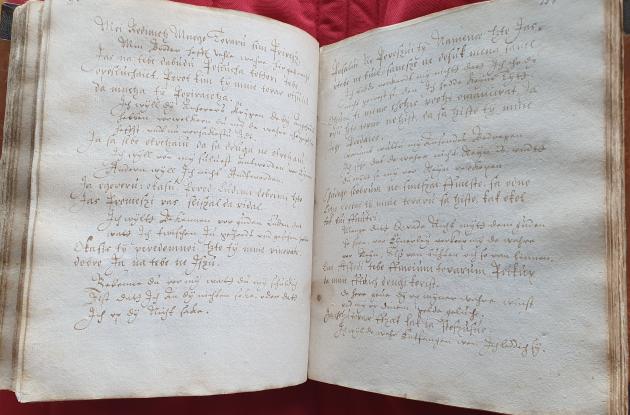Manuscript included in UNESCO's Memory of the World
Tönnies Fonne's handwritten textbook in Russian from the beginning of the 17th century has just been included in UNESCO's Memory of the World. The textbook is part of the library's collections.

Photo: Det Kgl. Bibliotek
Published 26 May 2023 | Revision 23 April 2025
A manuscript in Royal Danish Library's collections have been included in UNESCO's Memory of the World. The manuscript is a Low German textbook in Russian, which sends the reader directly back to the muddy and poor streets of a Russian city in the 17th century and allows us to hear the language that was spoken then. The book is thus a unique historical and linguistic source.
"You are going to regret that"
The textbook was written by the young Tönnies Fonne in 1607. Tönnies Fonne was the son of Hans Fonne. Hans Fonne was part of the Novgorodfahrerkompanie in the Hanseatic city of Lübeck, which meant that the family, like many other merchants in the city, traded in Russia.
Tönnies Fonne was therefore in the Russian trading town of Pskov in the years 1607-1608. It was here that he created his textbook in Russian for the practical reason that it is important for a merchant to be able to make himself understood in the local language. The work is characterised by this - for example, it contains a phrasebook where useful phrases are translated. It could be a sentence like, Dat werdt dÿ noch ruwen, dat du de wahre nicht gekofft heffst, de wahre werdt nicht behter kop werden
or in English: You will regret that you did not buy the goods, you will not find them cheaper
.
However, unrest spread in Russia from 1598 onwards due to succession disputes in the country. The unrest reached Pskov in 1609-1610, and therefore Tönnies Fonne returned home to Lübeck. He no longer needed his textbook and gave the manuscript to another merchant, Hinrich Wistinghusen.
The importance of the textbook
The Hanseatic League was an organisation of cities and merchants that connected up to 200 cities and dominated trade in Northern Europe from the 14th century to the 17th century. The textbook itself is an example of the Hanseatic merchants' activities in the cities where they traded.
The textbook documents the trade of the Hanseatic cities with the Russian area, and the many examples of sentences in translation show in a unique way the everyday language, both Russian and Low German, at the beginning of the 17th century.
Facts: UNESCO's Memory of the World
Memory of the World is a UNESCO programme that was launched in 1992 with the aim of preserving and disseminating the most important documents in the world.
Tönnies Fonne's textbook has just been included together with 16 other documents that document the history of the Hanseatic cities in various ways. The archive in the Hanseatic city of Lübeck has been the main applicant for the application, which involves 11 other institutions, including Royal Danish Library.
The following manuscripts in the library's collections are already on the Memory of the World list:
- Hans Christian Andersen's manuscripts and letters
- Søren Kierkegaard's Archive
- Hamburg Bible from 1255 (GKS 4 folio)
- Guaman Poma's El Primer Nueva Coronica y Buen Gobierno from approximately 1612 (GKS 2232 quarter)
The history of the manuscript
The textbook consists of 566 pages in quarto format and contains the following parts: introduction, dictionary, Russian grammar, phrasebook, proverbs, religious texts, examples of business letters and finally an overview of Cyrillic letters and numbers.
The signature on the manuscript is "Thott 1104 quart", and the manuscript thus originates from the Thott collection. The Danish landowner, statesman and collector Otto Thott (1703-1785) built one of the largest private libraries in Europe in 18th-century Copenhagen, of which he bequeathed all his manuscripts (4,154 numbers) as well as all books printed before 1531 (6,059 numbers) to Royal Danish Library. Many of the library's treasures come from Thott's library. We do not know how Thott had acquired the manuscript.
After the Slavist Adolf Stender-Petersen drew attention to the manuscript in 1918, its contents were published on the initiative of the linguists Roman Jakobson and LL Hammerich in four volumes by the Society of Sciences in the years 1961-1986. The four volumes contain a complete facsimile, a transliteration and translation into English and two glossaries. In 2008, Pepijn Hendriks and Jos Schaeken published a digital version of the manuscript's contents.
As a result of the inclusion on the Memory of the World register, we are now digitising the manuscript and digital photos of all the pages will be available in Digital Collections.